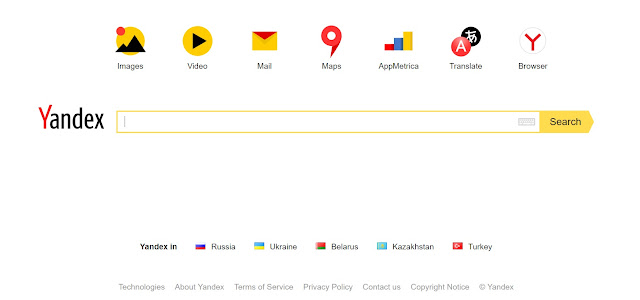Russia also officially known as the Russian Federation, is a sovereign country in Eurasia. At 17,125,200 square kilometres (6,612,100 sq mi), Russia is the largest country in the world by area, covering more than one-eighth of the Earth's inhabited land area, and the ninth most populous, with over 144 million people at the end of December 2017. About 77% of the population live in the western, European part of the country. Russia's capital Moscow is one of the largest cities in the world; other major urban centers include Saint Petersburg, Novosibirsk, Yekaterinburg and Nizhny Novgorod. (Information from wikipedia)
Yandex N.V. is a multinational corporation specializing in Internet-related services and products. Although most of its assets are in Russia, the company is incorporated in the Netherlands due to irregularities in Russian law. It is the largest technology company in Russia and the largest search engine on the Internet in Russian, with a market share of over 52%. The Yandex.ru home page is the 4th most popular website in Russia. It also has the largest market share of any search engine in the Commonwealth of Independent States and is the 5th largest search engine worldwide after Google, Baidu, Bing, and Yahoo!. (Information from wikipedia)
Yandex (YNDX) listed at Nasdaq with market cap US$11 billion. Below is the chart for Yandex shares price from 2017.
Yandex doesn’t just operate in the search engine space. The company has an email service and a cloud storage product. It has also launched a voice-enabled digital assistant called Alice. Yandex also has a ride-hailing and food delivery business. And in March, it formed a joint venture with Uber (valued at more than US$3.8 billion) to combine their ride-hailing and food delivery businesses in Russia.
Yandex has also developed a self-driving car (which it’s already testing in Russia). It also recently signed a deal with Russian state-run bank Sberbank to create a joint e-commerce venture. And it has introduced a new feature for online shopping in around 76,000 global stores and services that give customers the option of paying for purchases in installments. (Information from Stansberrychurchhouse)
FY 2017 Financial Highlights
- Revenues of RUB 94.1 billion ($1,632.9 million), up 24% compared with FY 2016
- Net income of RUB 8.7 billion ($150.3 million), up 28% compared with FY 2016; net income margin of 9.2%
- Adjusted net income of RUB 15.4 billion ($266.6 million), up 9% compared with FY 2016; adjusted net income margin of 16.3%
- Adjusted EBITDA of RUB 29.1 billion ($504.8 million), up 11% compared with FY 2016; adjusted EBITDA margin of 30.9%
Q4 2017 Operational and Corporate Highlights
- Share of Russian search market, including mobile, averaged 56.5% in Q4 2017, compared with 54.9% in Q3 2017, and reached 56.7% in December 2017, according to Yandex.Radar
- Search share on Android in Russia was 45.0% in Q4 2017, compared with 41.2% in Q3 2017 and 37.0% in Q4 2016
- Search queries in Russia grew 9% compared with Q4 2016
- Paid clicks on Yandex's and its partners' websites, in aggregate, increased 10% compared with Q4 2016
- Average cost per click grew 9% compared with Q4 2016
- Yandex.Taxi number of rides grew 250% year-on-year compared with Q4 2016
- Yandex launched Alice - the first conversational intelligent assistant designed for the Russian market
- The Federal Antimonopoly Service of the Russian Federation approved the combination of Yandex.Taxi and Uber ride-sharing businesses
- Yandex and Sberbank signed a binding agreement to form a joint venture based on the Yandex.Market platform
Q4 2017 Subsequent Events
- Yandex created Media Services (KinoPoisk, Yandex.Music, Yandex.Afisha and Yandex.TV program) business unit
- On February 7, 2018, Yandex completed the transaction between Yandex.Taxi and Uber in Russia and neighbouring countries
(Information from 4th Quarter financial results)
以上纯属个人分析与评论,如有任何疑问,欢迎与我交流讨论。任何股票买卖建议输赢绝对不负责。
From:林友志 (Lim Yu Chee)


